I usually post on Tuesdays, but this week’s deep-dive is a little late because I spent yesterday flying back from a month in Maine, back in LA for the time being! And instead of writing on the plane, I read Tom Lake and watched Almost Famous and ate pretzels. 🥨 Highly recommend all of the above.
In today’s post, we’re talking about whatever the opposite of the elephant in the room is—branding in AI. It’s everywhere. It’s not going anywhere. How should companies incorporate AI into their marketing and branding? More importantly, should they?
Also, my 4-week course on Maven, Brand for Growth-Stage Leaders is now open for its 5th cohort, starting September 2. You can enroll now or join the waitlist for updates—or send me a message if you’re thinking about joining!
You’re here because you recently subscribed or signed up for one of my resources—my course waitlist on Maven, lightning lesson, or Notion templates.
If someone sent you this post and you’re not subscribed, join those people learning how to tactically advocate for brand at your company. 📬
You can’t look anywhere without seeing AI. It hasn’t just taken over tech; even old-school consumer brands are fitting (shoving?) AI somewhere into their strategy. “Heinz A.I. Ketchup” (released in 2022!) and more recent “Have AI Break, Have a KitKat” TV spots are two examples. Both worthy of a watch, though a lot of AI branding is decidedly not 💩 worth your time.
Over the past three years, companies in all industries have rushed to integrate AI into their products and services (or at the least, to change all their messaging to say how they had). The AI branding space is simultaneously experiencing a moment of opportunity and saturation. Terms like “AI-powered,” “AI copilot,” and “all-in-one AI solution” (you should really stop saying “all-in-one,” but that’s another topic) have become ubiquitous and overused.
While the AI gold rush is just beginning, the branding landscape is already a “sea of sameness” that makes it difficult for companies, let alone specific features, to differentiate. Three of my former employers—Brex (“The AI-powered spend platform”), Notion (“Notion AI”), and Gusto—have significantly adopted AI as part of their product value prop, but only two of them changed their marketing accordingly.
Why is AI such a central part of some tech company marketing and barely mentioned in others? What role should it play in your branding?
Just because we can doesn’t mean we should
“How AI Affects Our Sense of Self,” published by the Harvard Business Review last year, should be required reading for any marketer. Toward the end of the article, after delving into the psychology behind how AI affects purchasing decisions, the authors state “the appropriate question when considering a move to AI and automation is not ‘Can we?’ but ‘Should we?’”
As a brand leader and marketing advisor, I’m asking myself this question often, adding “and if we do, how can our AI branding help us differentiate—and build trust?”
Marketing AI features and functionality have been mostly about capturing attention. Now that it’s “nothing new,” it’s time we focused on how it can build trust instead.
Starting from a place of low trust
AI has been memeable from the start. As it makes mistakes, tells us to put glue on pizza and eat rocks, how else are we going to make light of how terrifyingly unknown its impacts on our collective future will be and how ungoverned it is compared to its rapid rate of development? *Laughs in this is fine*
The result of both sudden ubiquity and lack of governance or standards is that many consumers (the people you want to buy your thing) are primed to be skeptical, bored, mocking, or even irate at your attempts to include AI in your messaging or in your products themselves. Lots of emotions.
That means you’re starting from a place of low trust. The stakes are high.
How, and if, to brand your AI
Marketing your AI: Everyone’s doing it. 🙄 How can you do it better?
I argue that AI branding needs to go beyond advertising the presence of artificial intelligence and instead emphasize utility and user value (what it actually does for you), and the complementary relationship between AI and human capabilities (how it makes your customer look good, not feel replaceable). It builds on the same principles of how we apply taste at work.
Here are some ideas (and a lot of examples sprinkled throughout) I’m putting forward to inform decisions about AI product branding:
Decide when and where to call it out
Use AI to make your customer look good
Focus on utility over technology
1. Decide when and where to call it out
Most SaaS platforms have used AI to automate some or many of their workflows. As the tech integrates into more aspects of business and daily life, mentioning it in marketing is becoming as redundant as saying your product is “online” or “tech-enabled.” Being “AI-powered” is no longer a differentiator.
Do you need to highlight AI?
First, let’s set the ground rule that at least until AI matures and becomes better governed, its use should be transparent. But you might not have to lead with it, either. Things to ask yourself, and your marketing and product teams:
Will not referencing the AI-driven aspects of the product be dishonest or misrepresent the experience in some way?
Does the user actually interact with AI in-product (vs. AI used for behind the scenes processes)?
Can the AI make mistakes that could negatively impact customers? Do they need to know that it can mess up?
Miro
I’m sorry, Miro, but nothing in your top-level messaging gets at why your workspace being AI-powered matters to me. What’s different about it now that it’s AI-powered? I literally have no idea.
Using the sparkle shorthand
When in doubt (i.e. leaning toward not mentioning AI), you can show instead of tell. A huge number of brands, Spotify among them, are using the spark icon ✦ to allude to AI-powered capabilities like Smart Shuffle: AI is specifically in play, but it’s not necessary to write copy about it. (I also think we’ll see this use decline over time as AI becomes more commonplace, rather than thrown on everything that is vaguely AI-related 😛 *:・゚✧*:・゚✧)
It seems we can credit Google for the association of sparkles (sometimes 🪄) with the presence of AI, iconography that’s now been mainstream for over a year. I wonder—are the sparkles the equivalent of the universal phone icon and email icon? Phones definitely don’t look like this 📞 anymore, and we still use the paper envelope ✉️ to denote email. Will ✨ forever be the universal symbol for AI? Love or hate the sparkles, it is helpful for creating a standard everyone can recognize, a shorthand that lets us cut the redundancy of saying “AI-powered.”
AI will go the way of “tech” and “online”
Look, no one’s saying “tech-powered,” because it sounds dumb. Michelle Cheng, author of the Quartz article “How ✨ became the unofficial AI emoji,” muses that “Maybe one day, capitalizing or even using the term AI will be a sign of dorkiness,” like capitalizing “Internet” or including a hyphen in “e-mail.” (I’m in the camp that, yes, it will be dorky. Even Apple’s moving toward dropping the “i” from iPhone. You can kill the periods in “A.I.” while you’re at it.)
Speaking of emojis, seems the consensus is that the rocketship emoji 🚀 has become the tell of ChatGPT-generated LinkedIn posts—time to put that one on ice if you’re (still?!) using it.
Gusto
You wouldn’t know that Gusto is leveraging AI on its backend to solve customer problems by looking at their homepage—because being AI-powered isn’t what’s important to the small businesses who rely on them to administer payroll and pay taxes. What matters is that those things don’t get messed up, they don’t get in legal trouble, and they don’t pay more than they have to. The product just needs to work, really well, and to keep delighting customers throughout their user experience—and it does.
Like at Gusto, AI on the backend is obviously the case at the majority of tech companies now—from FAANG (or whatever the latest acronym is) to YC. AI tools are best-in-market solutions for certain use cases, and any company building in those spaces has already or soon will migrate. Yet the urge to aggressively market the concept of AI without clear context has been infectious!
Brex
Brex has leaned heavily into this positioning for a year already: “The AI-powered spend platform.” I’m not sure how much longer this language will feel differentiated, especially as people get more allergic to the “AI-powered” phrasing.
Jumping into the Brex AI product page, its utility becomes a lot clearer, but here it’s positioned and branded as a standalone product (“Brex Assistant” appears to be also), when I think Brex AI is meant to be a functional experience layered across all other products. Do they need to position “Brex AI” as its own product, or can AI just be embedded into the product experience holistically, à la Gusto? If you look at the Travel page, for example, there’s no mention of AI features—it’d make sense to include them there rather than only on a separate page.
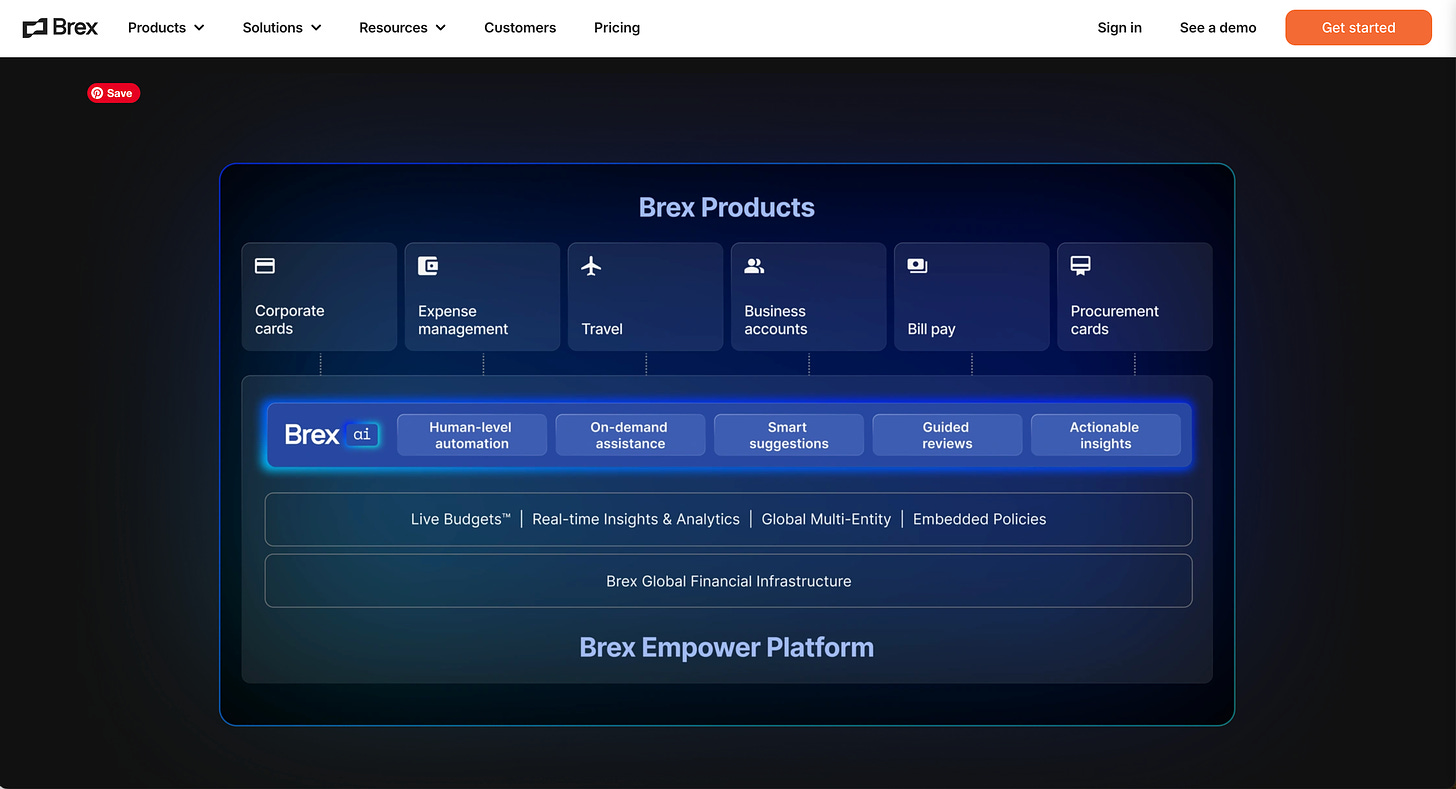
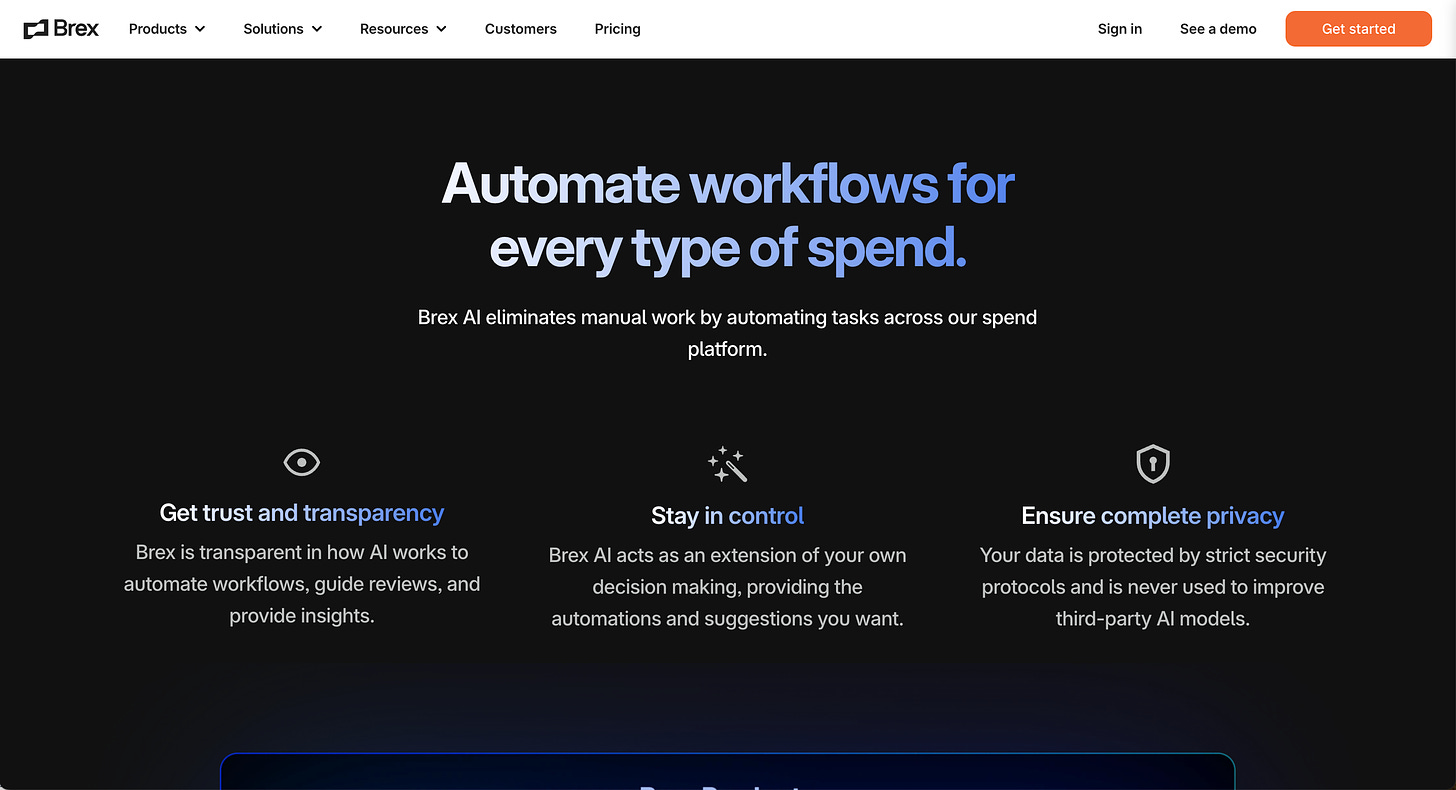
2. Use AI to make your customer look good
“Many people’s sense of self is rooted in their professional identity, and AI and automation can be perceived as undermining that identity if they threaten to devalue skills, expertise, or status.” (HBR)
The impact of AI on human identity extends beyond the professional sphere into our personal lives, challenging not only how we view our work but also our roles in intimate relationships. While many people’s sense of self is deeply rooted in their professional expertise, as highlighted by HBR, the reach of AI doesn't stop at the office door. Google’s “Dear Sydney” Olympics spot (pulled from airing) shows how even tech giants can misstep when deploying AI in sensitive areas like parenting and family bonding. (Or they’re purposely rage-baiting viewers.)
This overreach illustrates something crucial: as AI expands from handling routine tasks to more nuanced, emotionally charged domains, it risks not just devaluing professional skills but also intruding upon the deeply personal aspects of human identity. The challenge for companies marketing AI is twofold—to navigate the potential threats to professional identity while also respecting the boundaries of personal relationships that are fundamental to our sense of self.
“Dear Sydney” was gorgeously executed, but it’s one thing to have AI outline workout plans and another thing to insert itself in parenting responsibilities and father-daughter bonding.
AI use cases are no doubt going to get very personal, but given that one of the biggest threats AI poses to kids is ruining their critical thinking skills, this didn’t seem like a tasteful choice.
When marketing what AI can do, the stronger position is to showcase AI as a complementary tool that enhances and augments human capabilities rather than replaces them.
It doesn’t take Gallup reporting that three out of four Americans believe AI will reduce jobs to recognize that people are raising eyebrows about AI (see Intuit’s goof in my post about taste at work), and growth will come from easing those concerns rather than playing into them. The best leaders are self-aware of their company’s role in this cultural theme.
Let’s boil it down even more. Focus on how your product makes your customer look. good. At work. In front of peers. To their boss. With friends. Tell them how they’ll be better at their jobs, be more confident, and be a better leader/friend/boss/parent. (There’s a reason why Glossier’s tagline is “You look good.”)
We’re starting to see a telling shift from “AI-powered” to “with a little help from AI.”
If you want branding that engages audiences positively, rather than turns them off, first a) decide if it’s relevant to highlight AI at all, and 2) highlight how AI complements human skills and creates new opportunities, rather than replacing meaningful human interactions.
Notion
Language like “The AI-powered workspace” would be pretty meaningless to Notion’s audience (and any audience). But language like “Just ask Notion AI” immediately gives the user a sense of how they’ll interact (“asking”) with the AI element of the product (and when, and why).
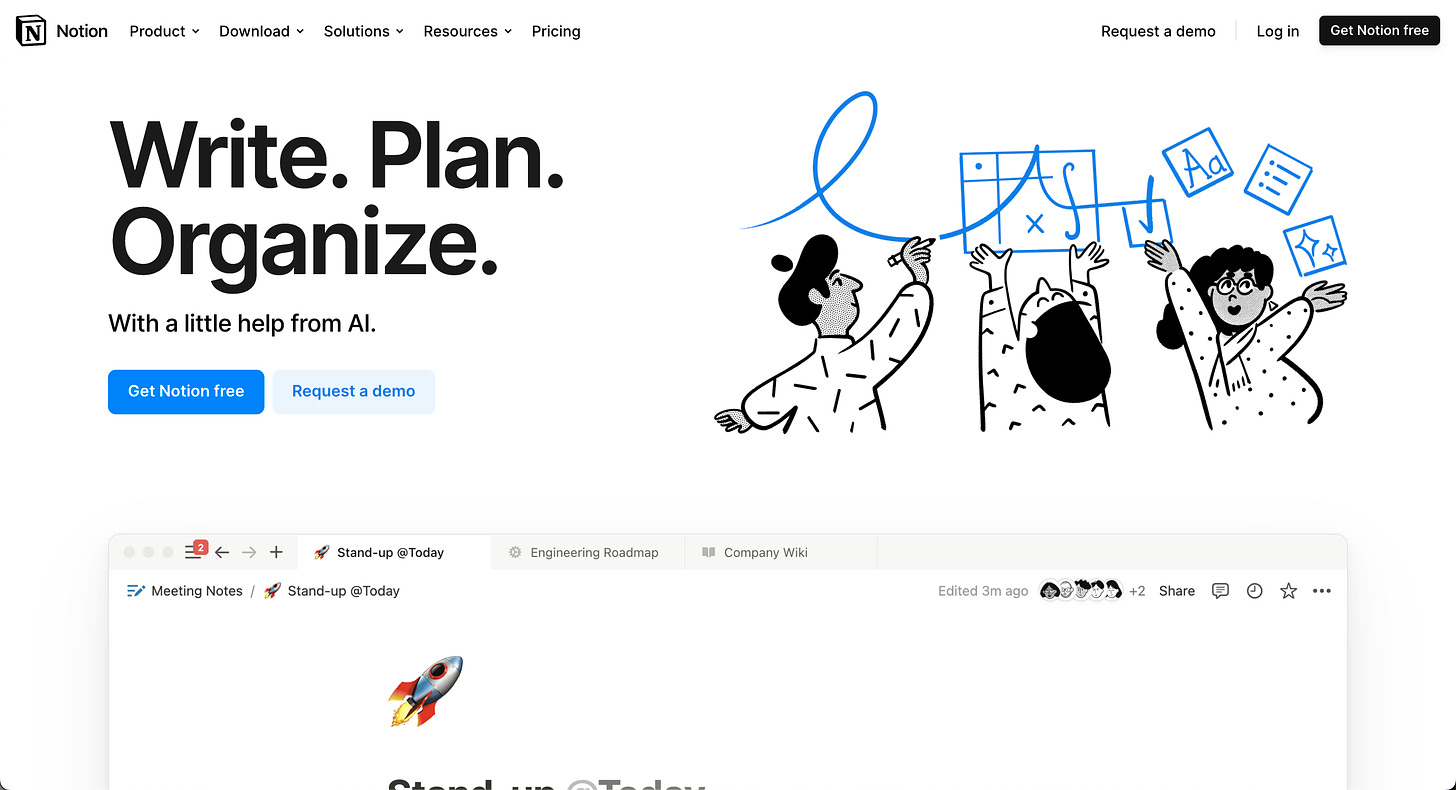
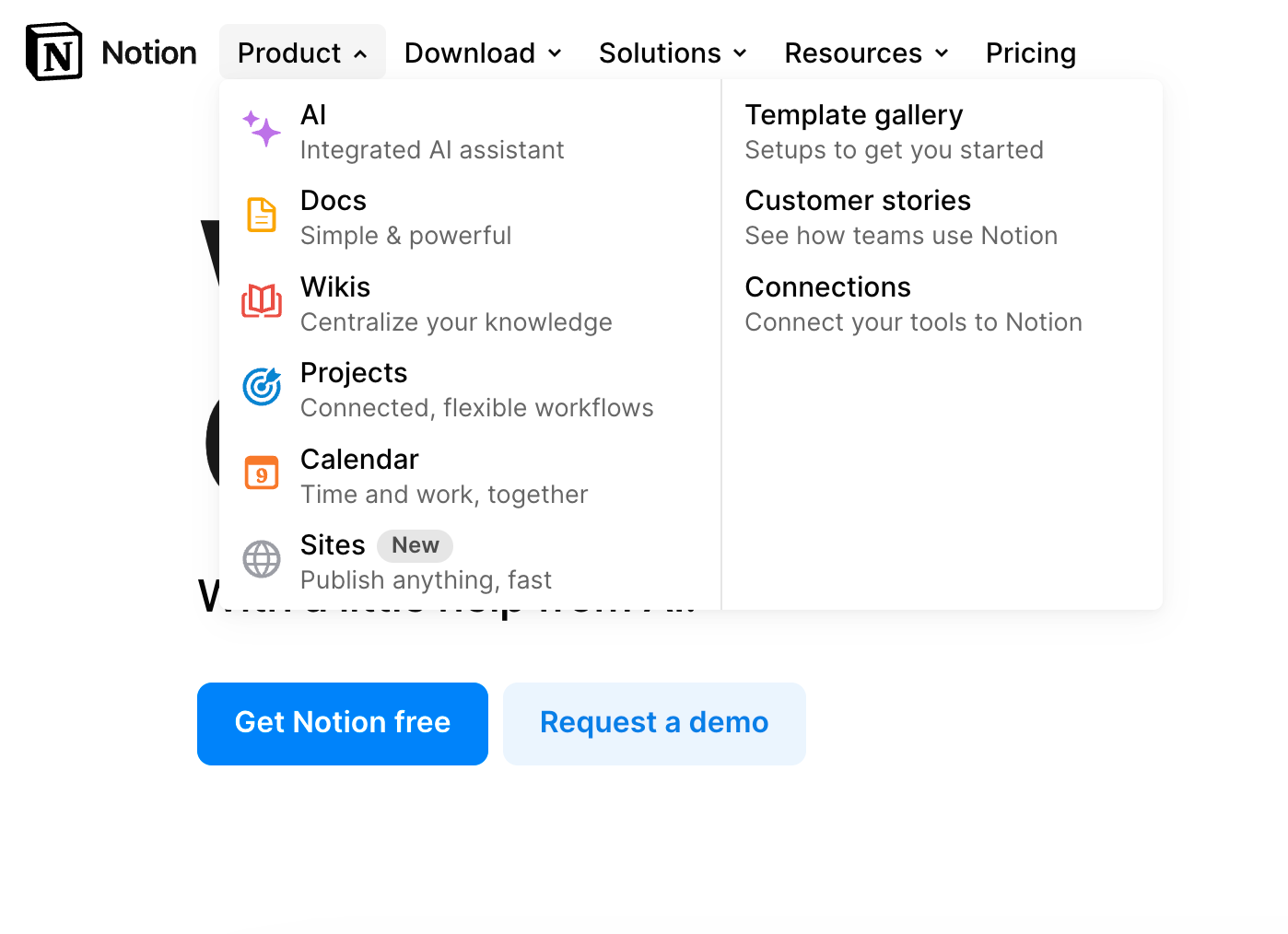
3. Focus on utility over technology
It’s not like AI branding has different rules from good branding in general: Be clear about who you’re for and how your product benefits them. What specific problems does your AI-backed functionality solve that are worth identifying them as such? What does the AI-powered part actually do? How does it make users' lives easier or more productive?
Grammarly
Grammarly was founded in 2009, so it’s definitely been “AI-powered” for more than just the past two or three years. At one point in recent history, Grammarly pivoted a ton of its branding to capitalize on the AI wave and marketed itself more outright as “an AI writing assistant.” Now, the emphasis is back on what actually matters—how it helps users communicate more effectively and confidently.
“Responsible AI that ensures your writing and reputation shine” is a solid headline that addresses writers’ concerns (sounding good, using AI ethically). “Reputation” and “responsible” are great notions to align themselves with.
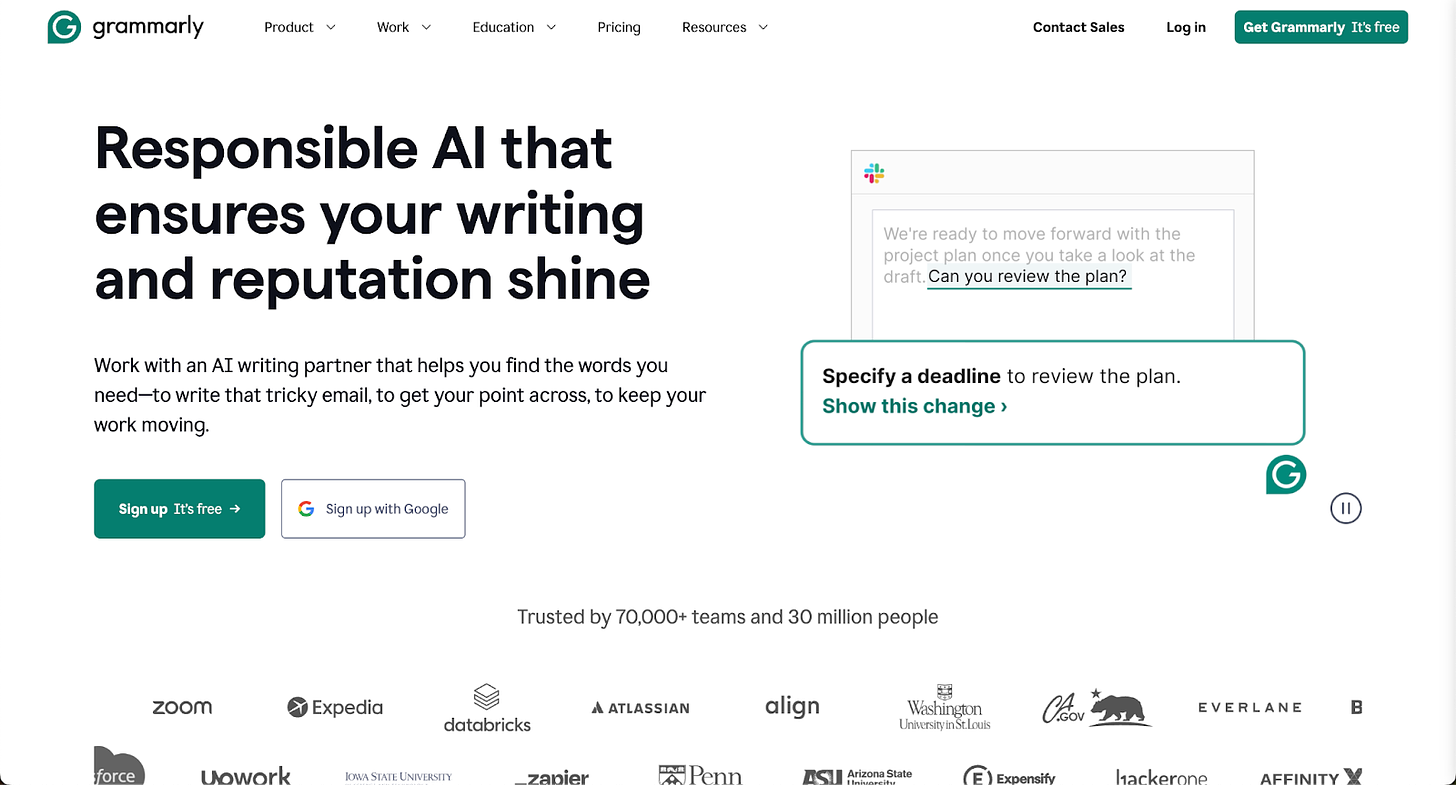
Instacart
The search results for these suggested queries (you can type anything) are clearly powered by AI. But that fact doesn’t matter at all to the customer browsing Instacart for ingredients or recipe ideas. It’s a perfect example of focusing on utility rather than technology.
For companies where user-facing AI is the product, like Perplexity, Claude, or ChatGPT, both product and brand differentiation is everything. Marketing and branding needs to emphasize unique approaches or specializations. Perplexity, for example, emphasizes its ability to provide direct answers with cited sources, distinguishing itself in the AI search market (though I’d guess not for long?).
When it comes to branding AI features within existing products, companies need to consider whether to integrate AI branding seamlessly (in some cases not highlighting it at all) or to highlight it as a standalone feature.
And as AI matures as a technology, branding strategies will need to adapt. I predict we’ll shift away from explicitly mentioning AI, much like how “digital” or “smart” have become implicit in many product categories. Successful AI brands of the future will focus on specific outcomes, user empowerment, and ethical considerations rather than the underlying technology itself. If you’re already there, you’re ahead of the pack.
More examples
There’s no shortage of examples (to avoid and to follow) in the landscape right now—sharing more with my high-level commentary below: Gong, Superhuman, Zapier, HubSpot, Zendesk, Intercom, Databricks, ZoomInfo.
Gong
Gong, it’s weird for you to call yourself an “AI platform” when you aren’t Anthropic or OpenAI. A clearer headline would be “Transform your revenue growth” or even “Accelerate your revenue growth.” “Revenue intelligence platform” may be jargon-y, but at least it’s more specific than “AI platform” (don’t confuse customers by using both).
Superhuman
Superhuman could be clearer with what’s “AI-powered” about its email experience. I’ve been a user for years, but this mostly seems to refer to AI-generated replies and email topic summaries (pretty basic functionality). Does this really “power” my experience? Or would it be more effective to double down on their existing value prop—getting through email faster, getting to inbox zero? The only inbox that gets you to zero? The 60 to zero inbox? Something there, eh?
Zapier
Zapier is confusing its value prop by emphasizing AI. Rather than AI (a generic term everyone can use) giving me automation superpowers, doesn’t Zapier give me automation superpowers? (Are we still saying superpowers? 🤧) Zapier’s built their platform around connectivity and automation for years; they don’t need to muddle that now. If Zapier delivers on that promise, I don’t care if it uses AI or not (I’m going to assume it does and get on with my work).
HubSpot
HubSpot is a classic example of a product with strong product-market fit and weak brand-market fit. The number of AI references scattered across this page feels random at best (like, just a generic “AI Chatbot” graphic on the above-the-fold image? Okay). No idea what an “AI-powered customer platform” is or means.
Zendesk
This is an interesting one. Intercom and Zendesk both clearly want to take the edge when it comes to integrating AI into traditional customer service platforms, and Intercom’s branding is lot more visionary with it. But “Catered to humans” (who really matters) and “trained in the art of customer service” (respecting the industry’s roots) are nice notions. As AI gets more ubiquitous, I think Zendesk can ease up on the AI-first messaging and let speed-plus-human-touch be its signature.
Intercom
I love the vision here, and that the creative team took some risks with the homepage. I like that they described AI’s role with different users (what customers get, what agents get, what leaders get). But after “AI-first” settles, there’s not enough emphasis on the actual utility behind all this. Seems that “instant” is actually the value they’re focused on, but that (and what this all ultimately enables for teams and customers) gets a bit lost in this sci-fi vision of the future.
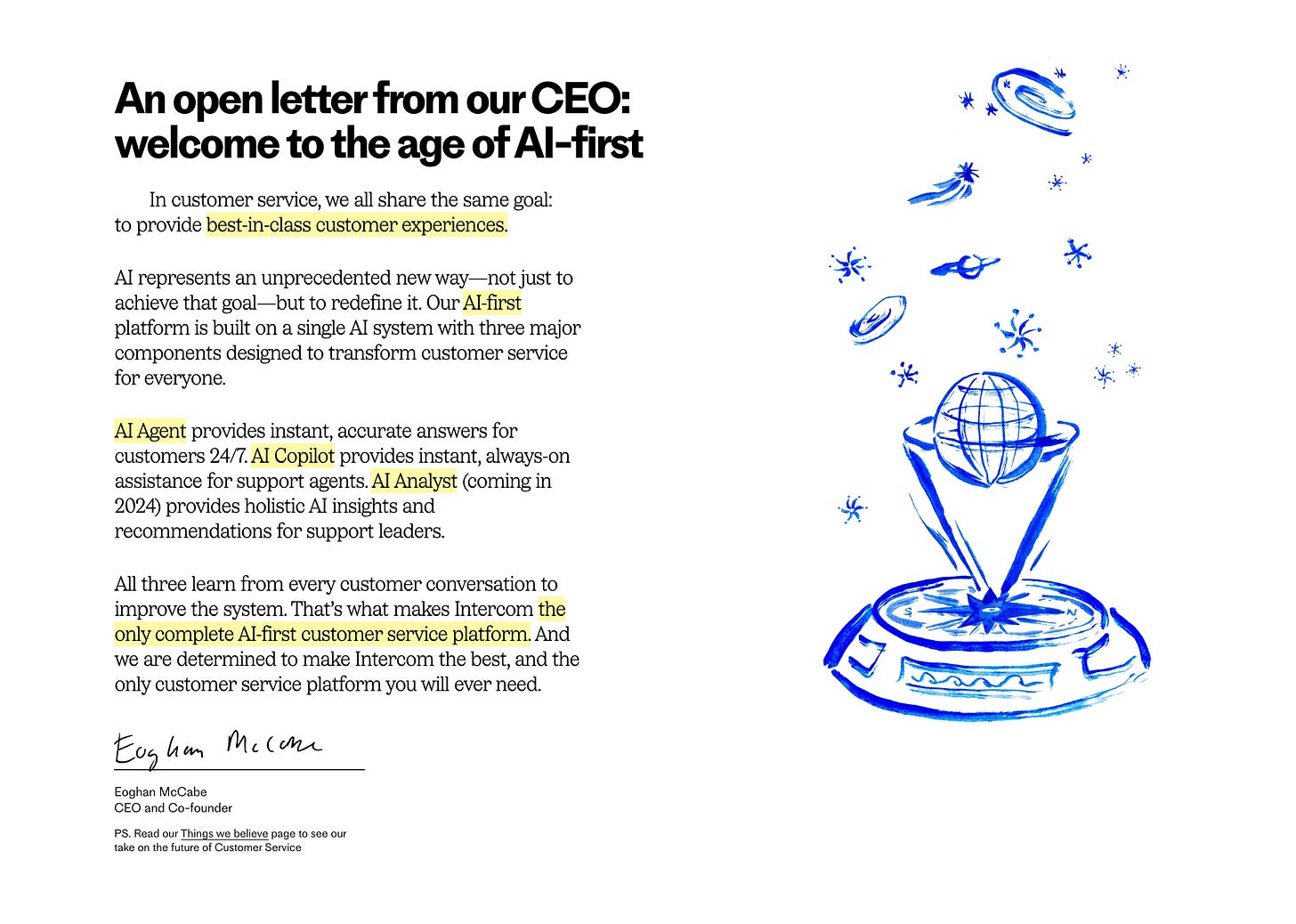
Databricks
I’m not their target audience, but it’s taking me more than a few minutes to figure out what Databricks actually is/does, so that’s all I have to say about this one.
ZoomInfo
Oof—we’ve got “Copilot,” “AI-driven,” “powered by Ai” all on one page. If we reoriented this messaging to focus on utility, it might read something like “ZoomInfo helps your sales team focus on the best accounts, spend more time selling, and close faster by surfacing relevant B2B intel.” AI can power that all on the backend, but it’s not the immediate problem sales teams are trying to solve for.
My 4-week course on Maven, Brand for Growth-Stage Leaders, includes a tactical deep-dive into this exact challenge—how to position your brand to resonate with your audiences. The 5th cohort, starting September 2, is now open. You can enroll now or join the waitlist for updates.
What AI branding do you admire? Which companies should we look at next?
If you liked what you read, consider:
saying hi or dropping a question in the comments!
connecting with me on LinkedIn: 👩🏼💻 Kira Klaas
sending to a friend 💌 or coworker 💬






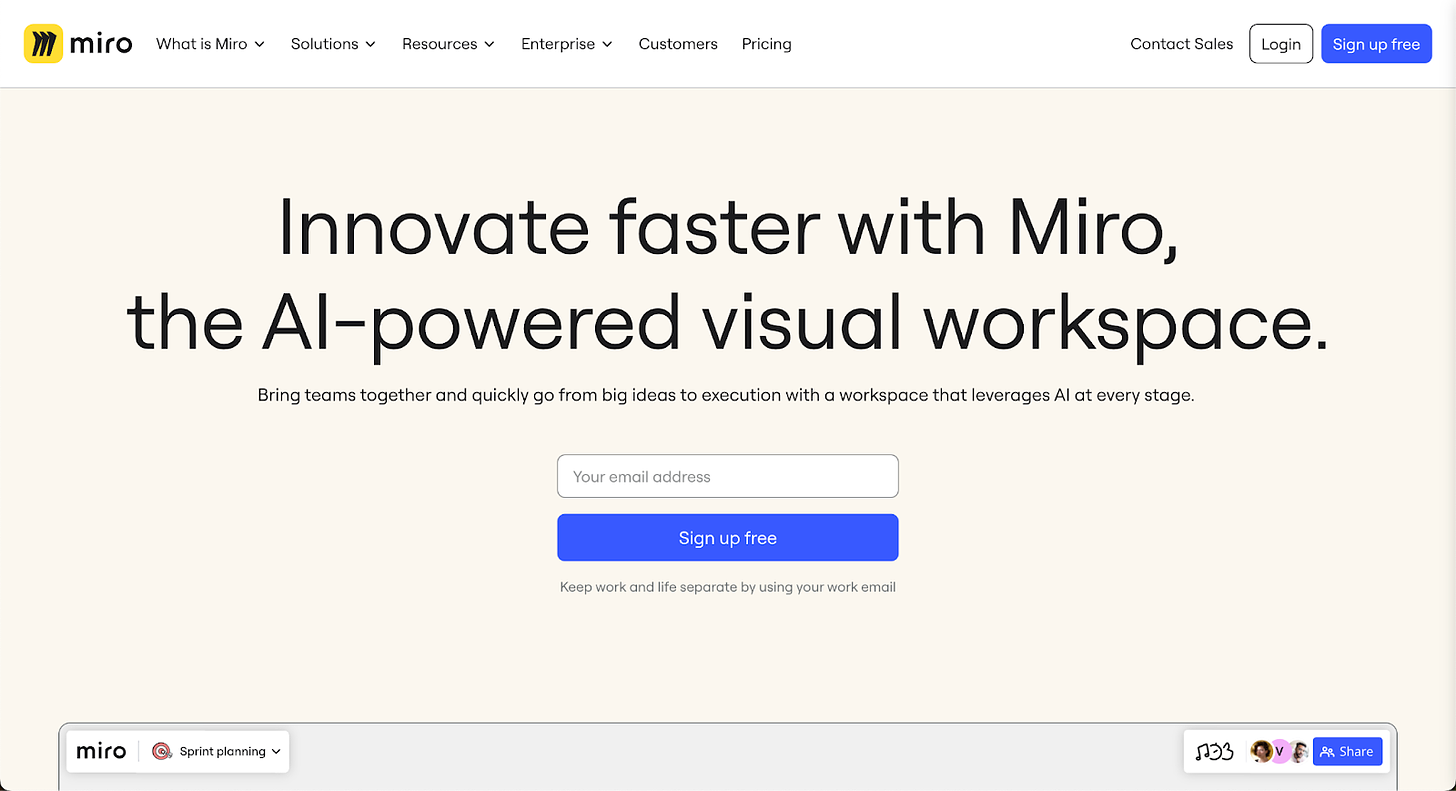


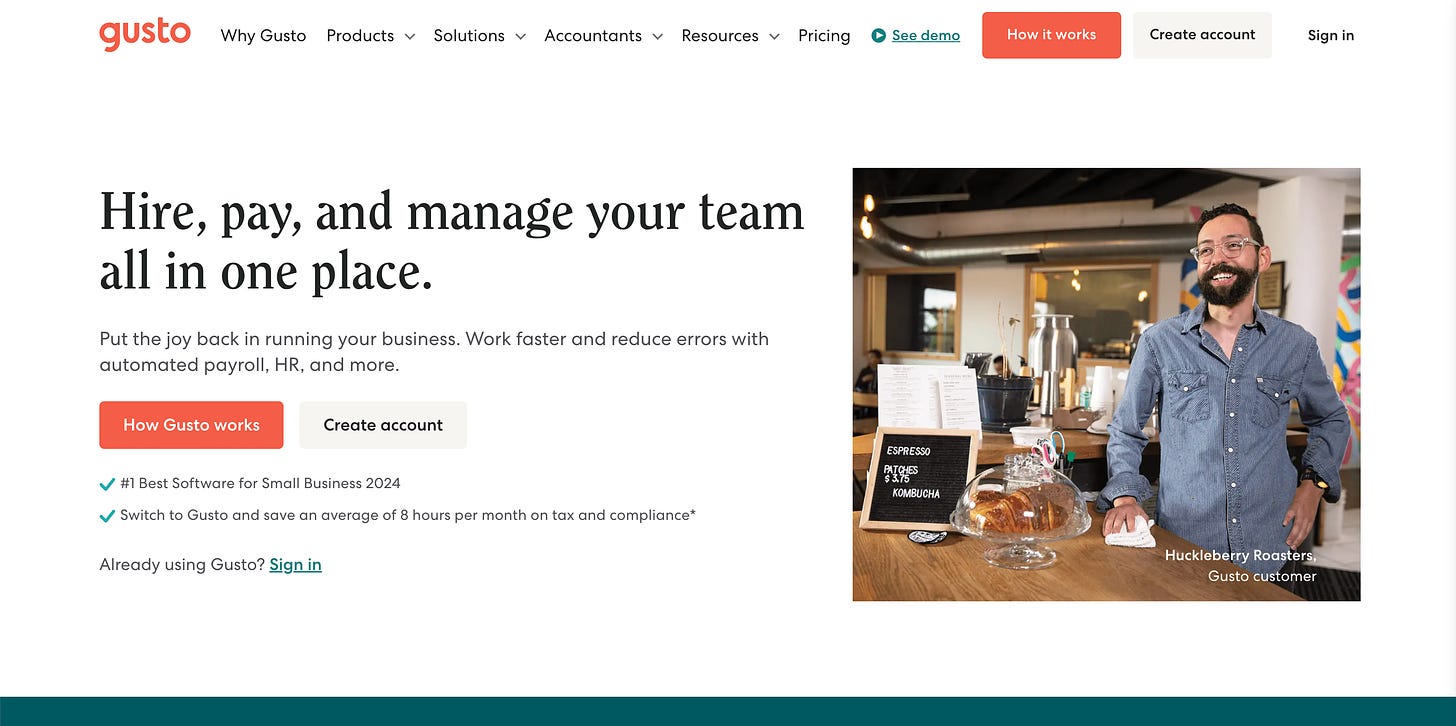
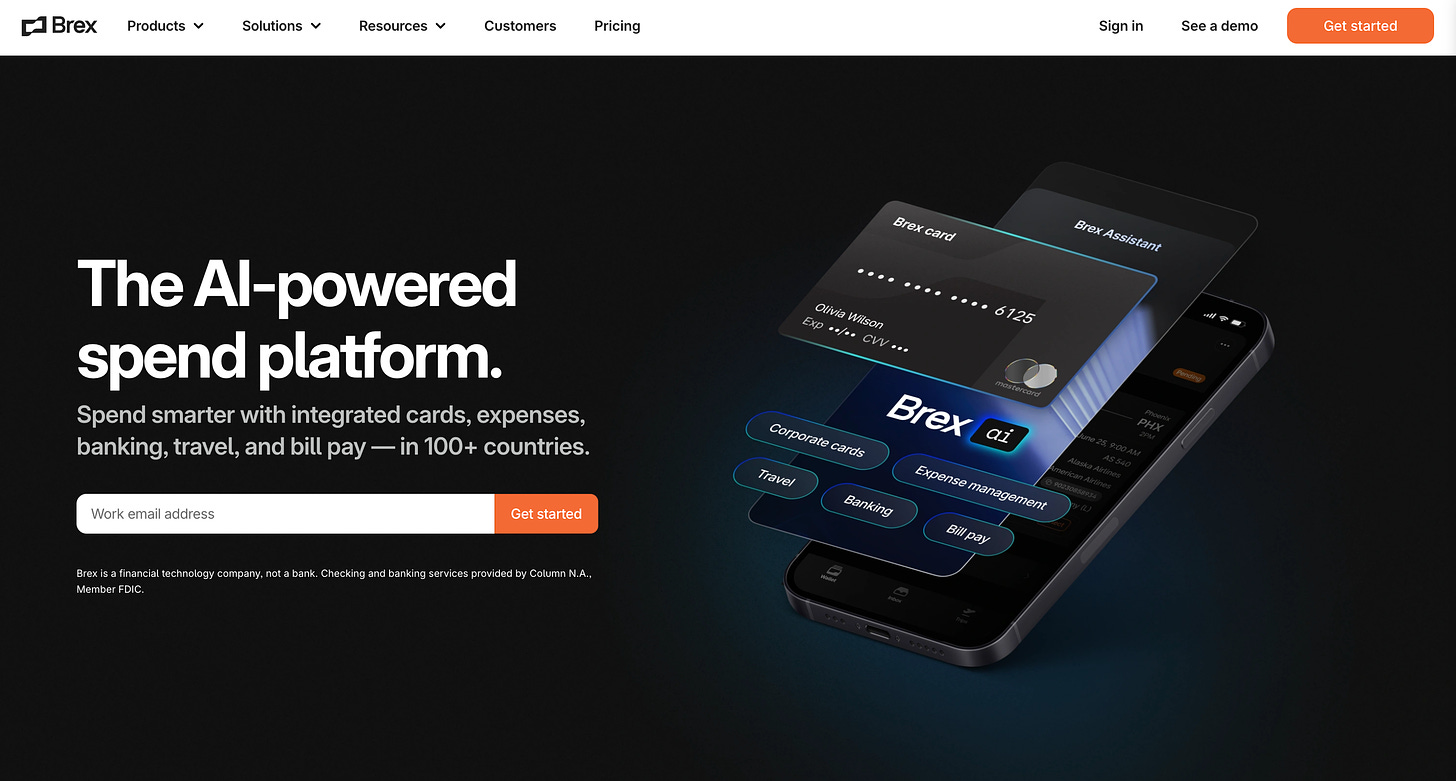

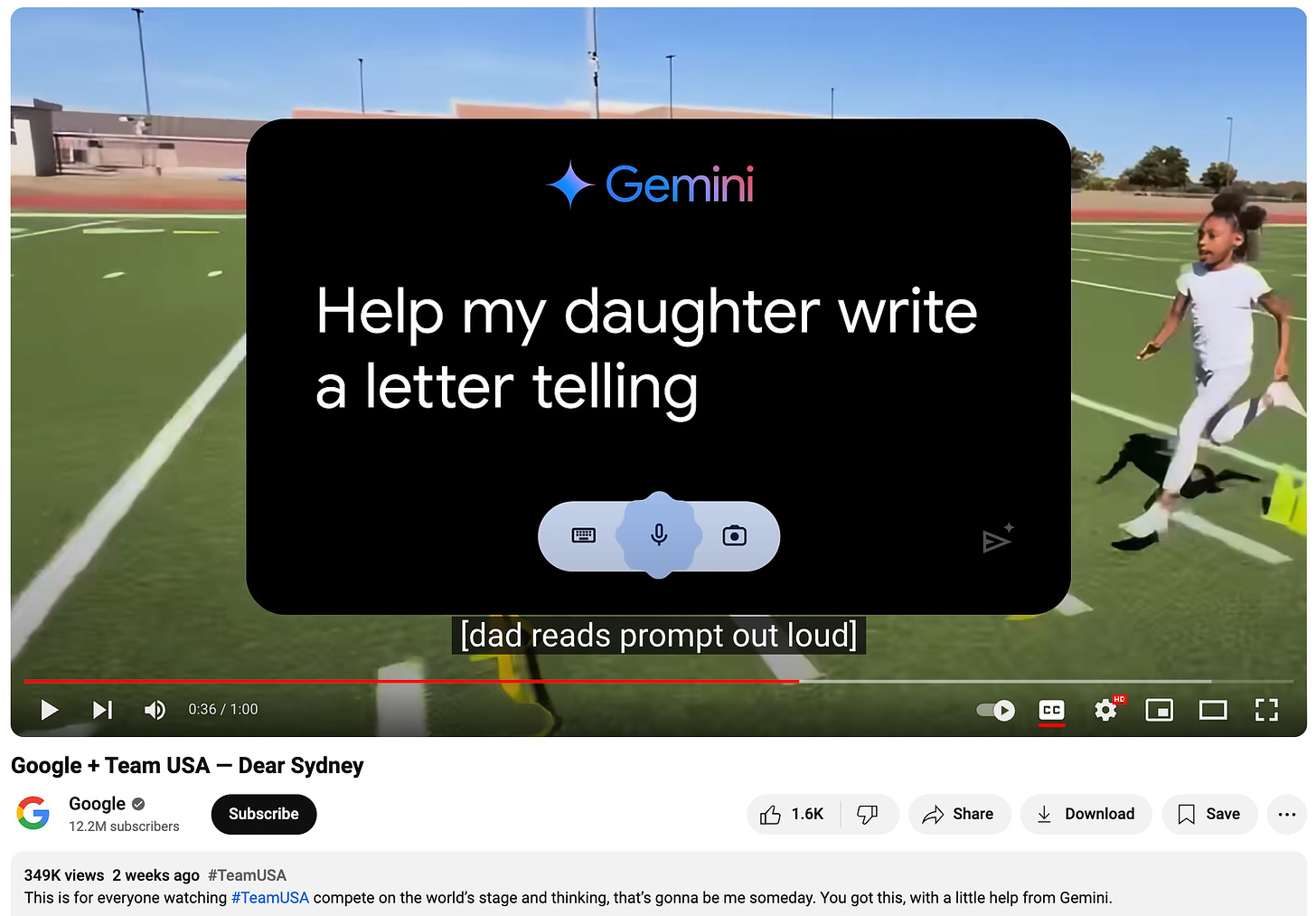
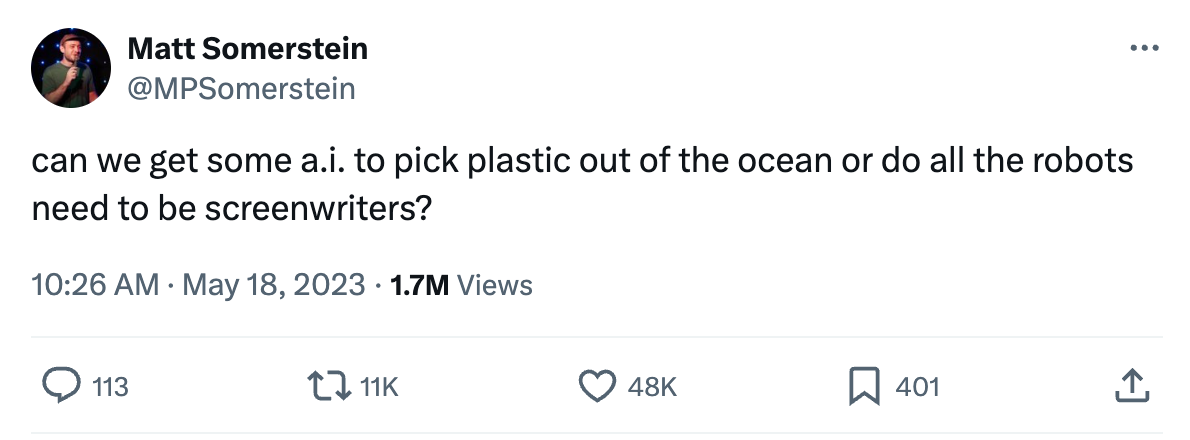

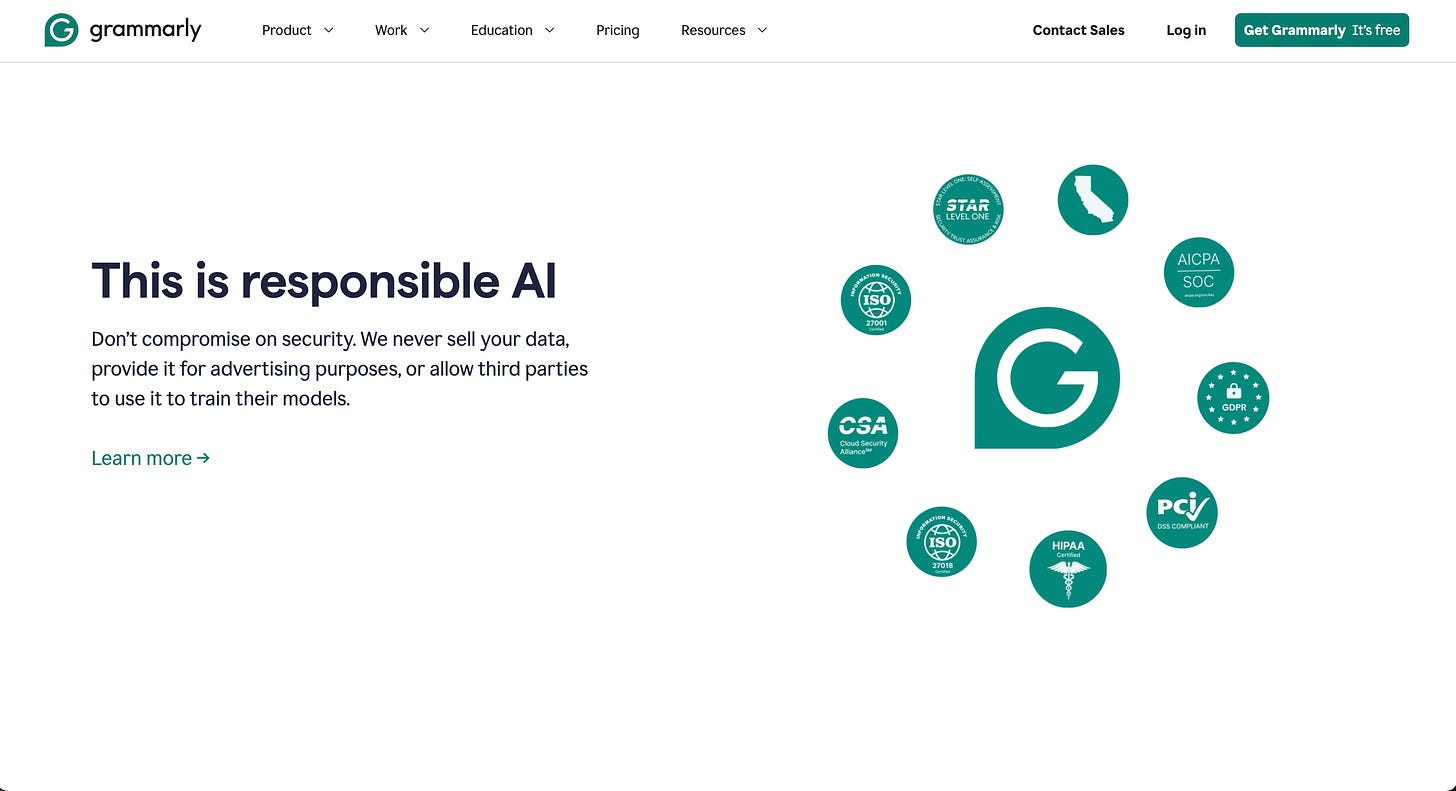




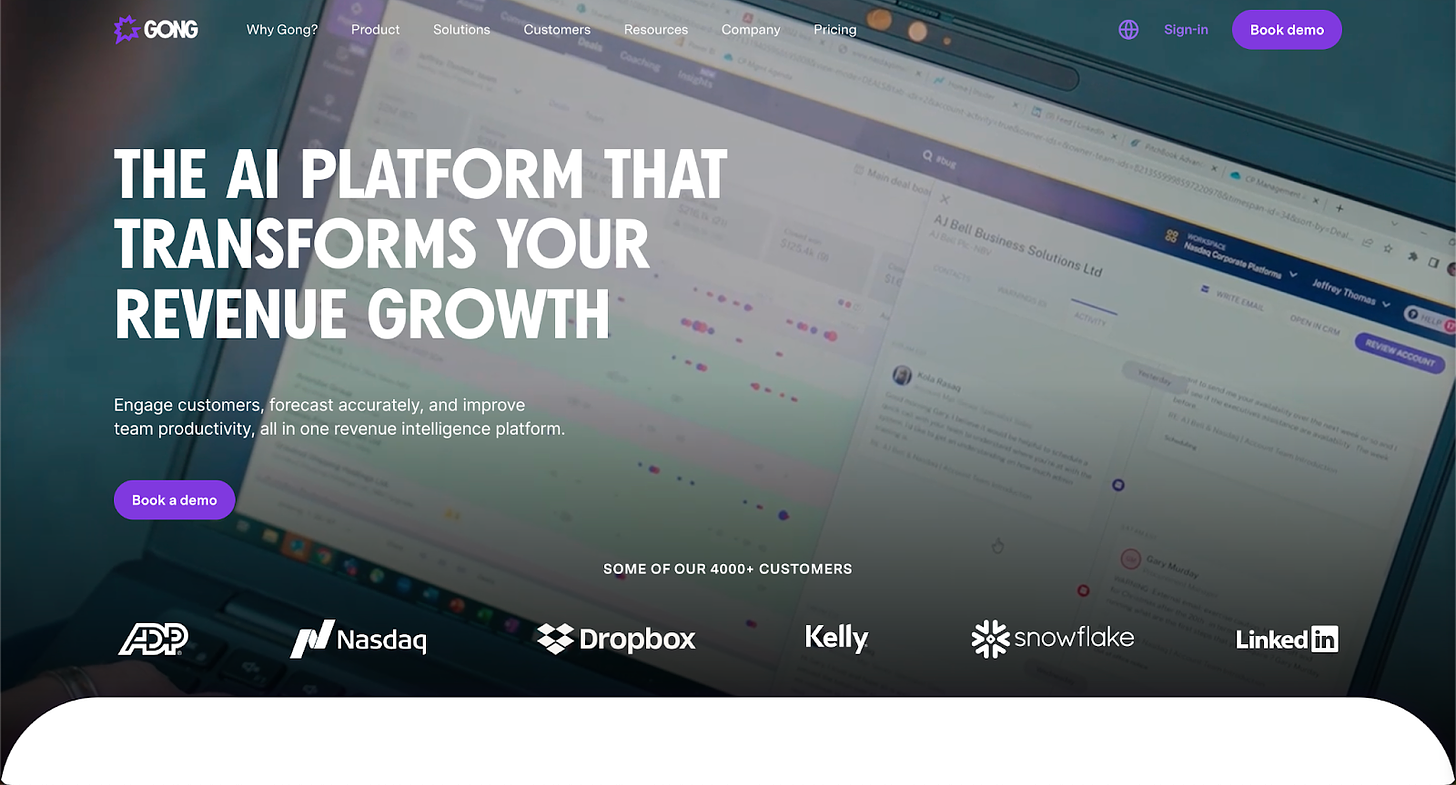
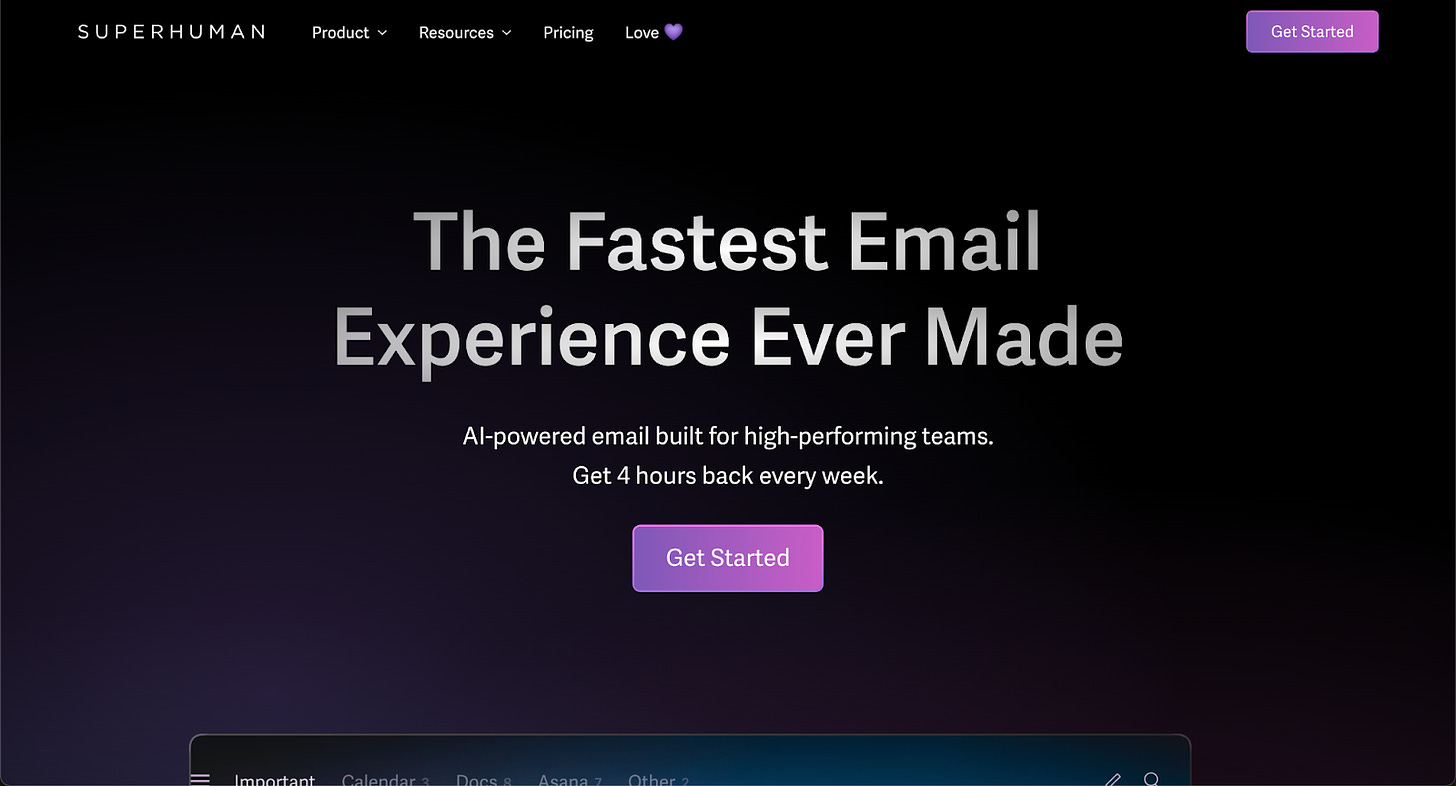

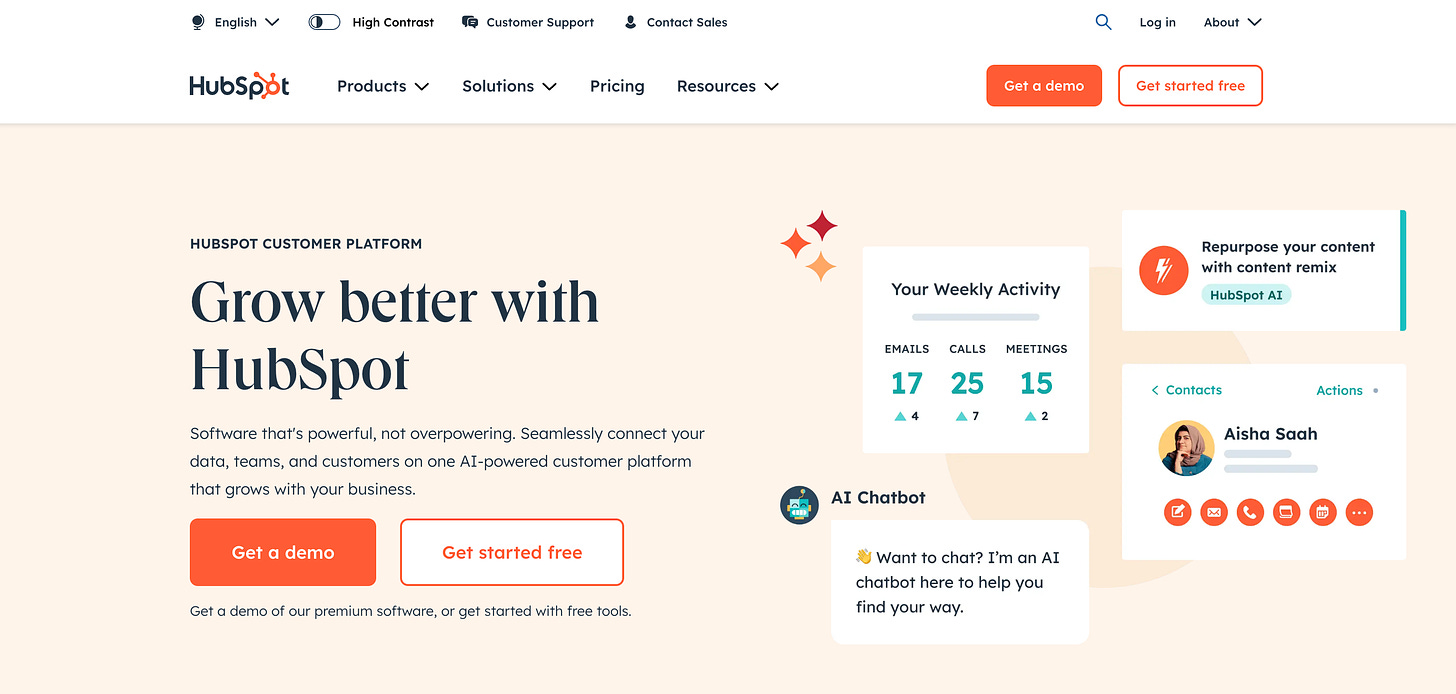

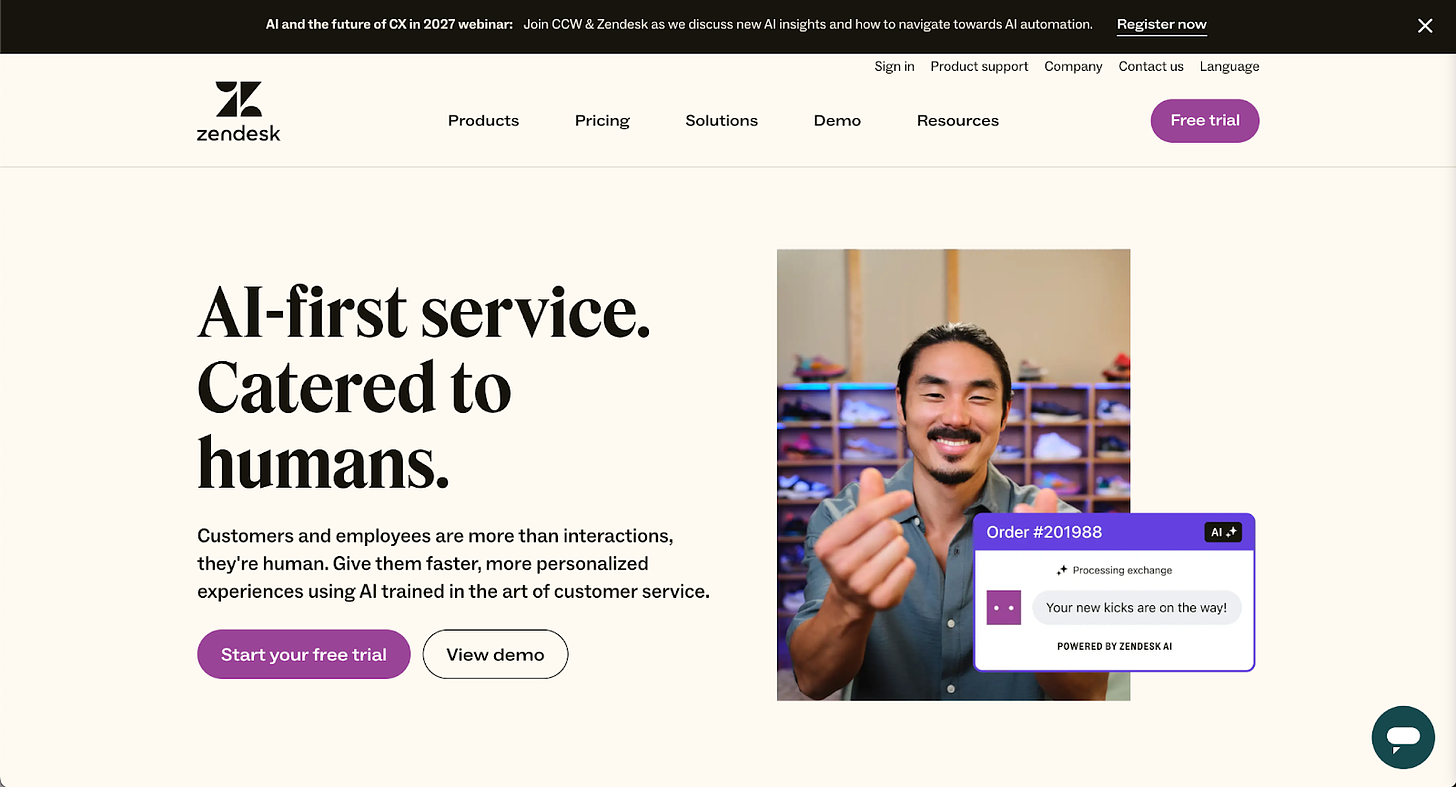
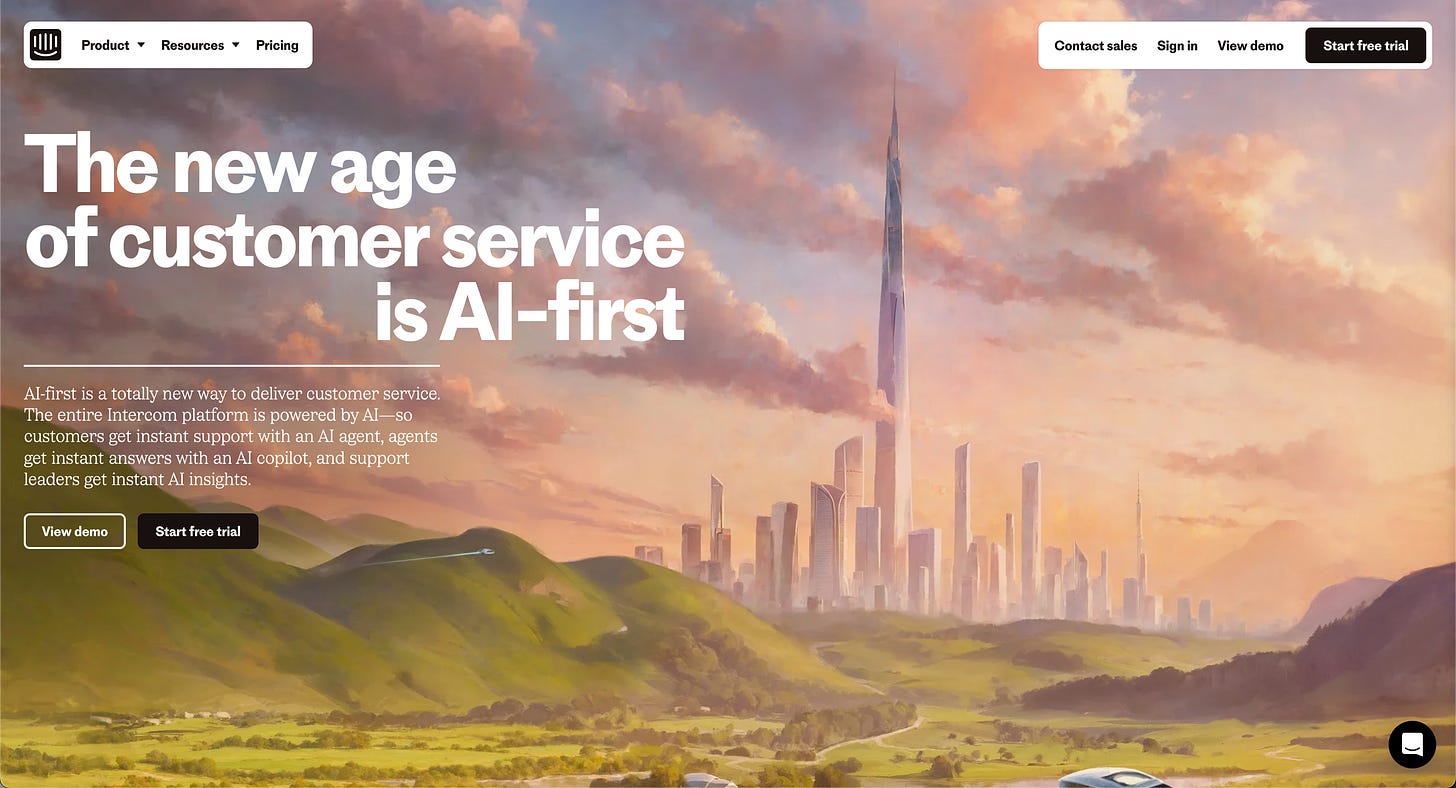

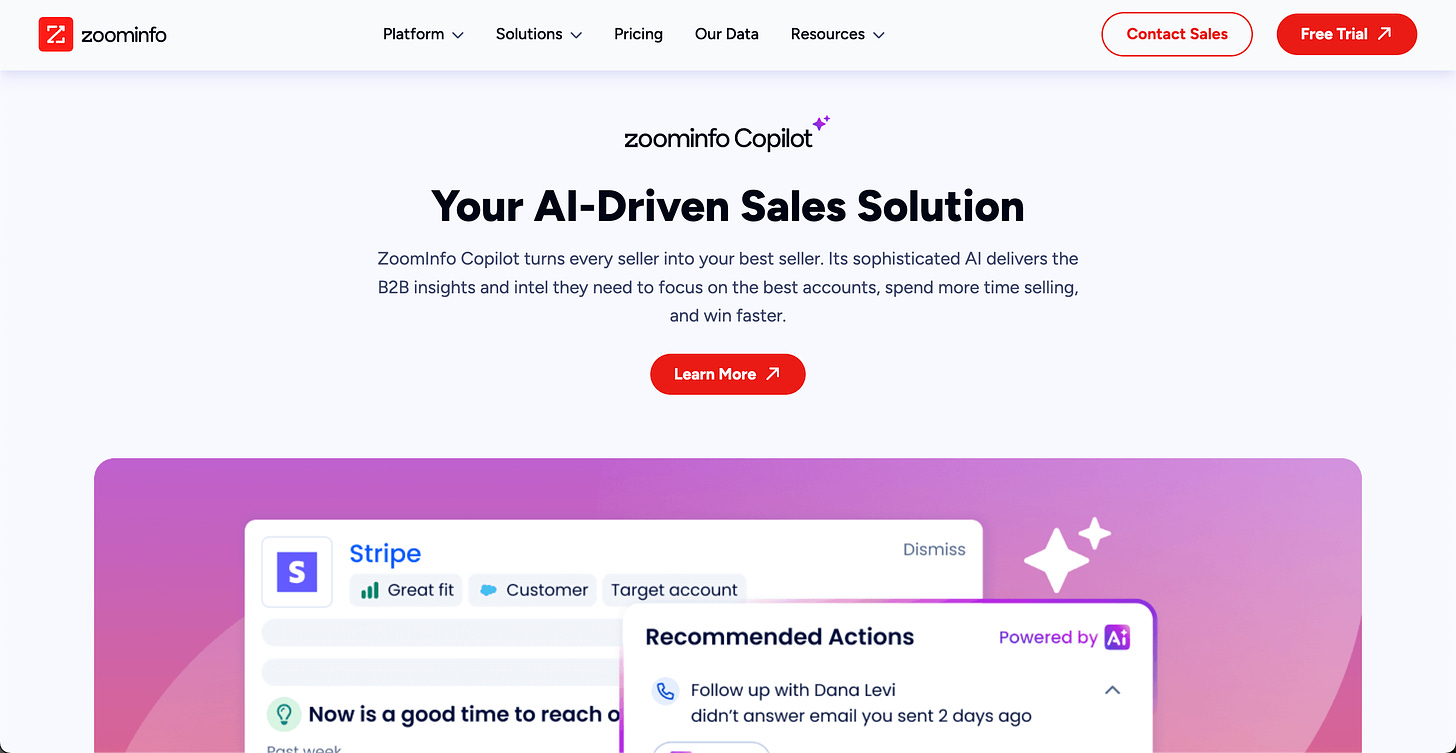
Incredibly well thought out article, Kira. Tech companies could really benefit from looking at how CPG brands have done this successfully for years. It's the difference between Aspartame Soda and Diet Coke; Soy Protein Patties and Impossible Burgers. Consumers are less interested in how something is made and care more about what it does or unlocks for them. With AI becoming the norm and dare I say a dirty word, we have to encourage brands to lean into their greater value props if they want to cut through the noise and stay around to see through whatever the next thing will be.